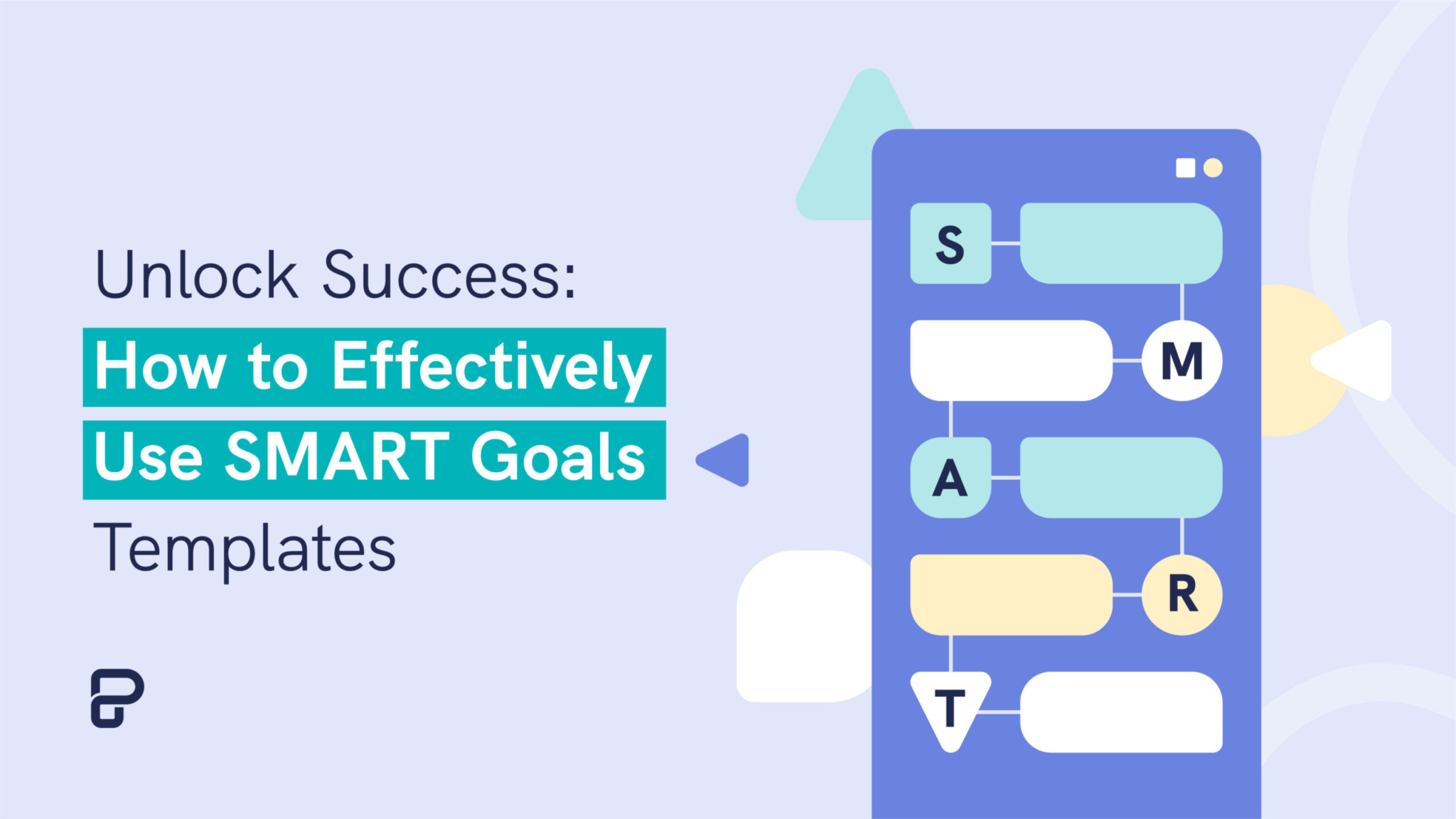In full disclosure, Piktochart uses OKRs since 2019. However, OKRs are a derivative of SMART and we will also go through them.
Table of contents
- How has Piktochart benefited from using OKRs/SMART Goals?
- What is a SMART goal?
- History of SMART goal framework
- Why is it important for you to write SMART goals?
- Examples of SMART goals at work
- Examples from companies
- SMART Goals examples by teams
- Try one of Piktochart’s Free SMART Goal templates
- How are SMART goals different than OKRs?
- Conclusion
How has Piktochart benefited from using OKRs/SMART Goals?
Piktochart has achieved remarkable benefits through the effective implementation of Objectives and Key Results (OKRs) since 2019!
The OKR framework has empowered the company to align and engage all teams around measurable goals, leading to focused efforts and enhanced cross-functional collaboration. As a result, Piktochart’s teams have accelerated the delivery of valuable product features and improvements, delighting users and boosting engagement.
The inherent transparency of OKRs has fostered a culture of open communication and shared responsibility, fueling team morale and driving innovation.
As a CEO, I wholeheartedly endorse the effectiveness of SMART goals in promoting alignment and igniting a sense of purpose when people own SMART goals in pursuit of shared objectives. And when leveraged in tandem with OKRs, their impact is truly remarkable!
But even at a personal level, they may help you acquire the necessary skills for your professional goal attainment.
Let’s dive into this blog post!
Piktochart offers professionally designed templates for presentations, posters, logos, email signatures, infographics, and more. Customize all templates according to your brand assets in seconds. Get started for free today to access our template gallery and toolkits!
What is a SMART goal?
SMART goals create the ability to clarify your intentions, focus your efforts on final goal, and use your time and resources productively to achieve what you really want to achieve in life. The SMART acronym stands for:
Specific
The goal must be clear and well-defined, not vague or generalized.
For example, instead of saying “I want to lose weight,” a more specific and measurable goal would be “I want to lose 10 pounds.”
Measurable
The goal should include specific criteria that can be used to track your progress and determine when you’ve achieved your goal. Using the previous example, the measurable aspect is the 10 pounds.
Achievable
The goal should be realistic and attainable to be successful. In other words, it should be within your abilities and resources to achieve. It’s fine to aim high, but be sure that it’s possible to reach the goal you’ve set.
Relevant
The goal should matter to you and align with other relevant goals. It needs to fit into your long-term plans and be important to the path you want to take.
Time-bound
The goal must have a deadline. This creates a sense of urgency and can motivate you to get started. For the weight loss example, a time-bound goal could be “I want to lose 10 pounds in three months.”
Using the SMART (specific measurable, attainable goals, relevant time-bound) goal framework can help you create more effective goals and increase your chances of achieving them.
History of SMART goal framework
The SMART acronym was first used in the context of management and business goal-setting in the November 1981 issue of the magazine “Management Review” by George T. Doran, a former director of corporate planning for the Washington Water Power Company. The title of the article was “There’s a S.M.A.R.T. Way to Write Management’s Goals and Objectives.”
In the article, Doran presented the SMART framework as a way to improve the chances of succeeding in accomplishing a goal. His original definition of SMART was slightly different than the one commonly used today, but the core ideas were the same.
Since then, the SMART goals concept has been widely adopted in business, education, personal development, and other areas. It’s been further developed and popularized by many authors and professionals in the field of goal-setting and management, such as Peter Drucker with his Management by Objectives concept.
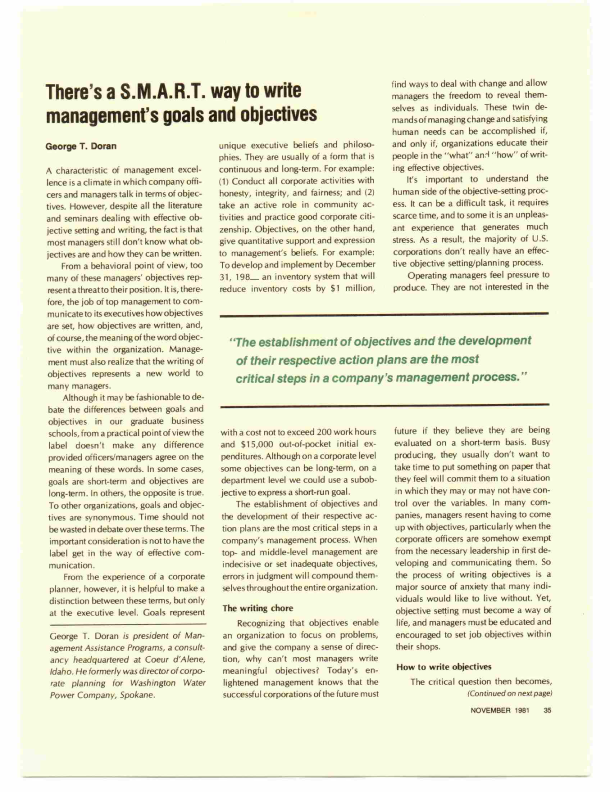

Why is it important for you to write SMART goals?
It is important to take time to set SMART goals because they provide a clear, concrete, and actionable framework for setting and achieving objectives, whether as professional goals, in education, or business. Here are a few reasons why it’s beneficial to use SMART to set goals:
- Clarity and Focus: SMART goals are very specific goals, meaning they help you clearly define what you want to achieve. Clear goals keeps you focused on specific tasks and avoids irrelevant goal.
- Track Progress: Because SMART goals are a measurable goal, you can track your progress. This can motivate you to keep going, especially when you start to see tangible results.
- Realistic Expectations: Having an achievable goal ensures you’re not setting yourself up for failure with unattainable goals. Instead, you’re creating a goal relevant to your abilities and resources.
- Relevance: By ensuring your SMART objectives are relevant, you align them with your broader objectives and life plan. This makes it more likely that you will stay motivated and committed to your relevant goal and achieving them.
- Timely Success: SMART goals are time-bound goals, creating a sense of urgency. This helps prevent everyday tasks from taking precedence over your longer-term goals. Having a more goal specific deadline can also increase motivation, providing a time frame that can be used for planning and monitoring your progress.
In summary, SMART goals increase the likelihood of achieving your objectives by making the process more structured and manageable. They reduce ambiguity, improve motivation, and set a clear path towards your goals, which ultimately leads to a higher rate of success.
Examples of SMART goals at work
Setting SMART goals meaningful objectives can help to effectively measure progress, foster teamwork, and improve areas of weakness. They can be applied to any work-related goal and can encompass various aspects of business development, professional growth, employee performance, or team effectiveness.
Here are some examples of SMART goals at work:
1. Sales Department
Increase sales by 15% by expanding into the untapped local market sectors by the end of Q2.
2. Customer Service
Improve customer satisfaction ratings by 20% by implementing a new customer feedback system and using new skills by providing team training in new skills over the next six months.
3. Marketing
Increase website traffic by 30% over the next four months by implementing a content marketing strategy and optimizing SEO.
4. Human Resources
Reduce employee turnover by 10% over the next fiscal year by developing an employee engagement program and conducting a bi-annual satisfaction survey.
Examples from companies could include:
1. Google
In early 2000s, Google set a goal to index over one billion pages on the internet. It was Specific (index one billion pages), Measurable (the number of pages indexed could be counted), Achievable (although ambitious, it was within Google’s capability), Relevant (core to Google’s service), and Time-bound (though the exact timeframe isn’t public knowledge).
2. Starbucks
In 2008, Starbucks set a goal to source 100% of its coffee ethically by 2015. This goal was Specific (source ethically), Measurable (percentage of ethically sourced coffee), Achievable (with effort and planning, it was possible), Relevant (integral to their business model and brand image), and Time-bound (by 2015).
Remember, these goals should be revisited and revised as necessary, to accommodate changes in the business environment and the company’s strategic direction.
SMART Goals examples by teams
We asked 6 leaders at Piktochart and here are real life SMART goals examples by Piktochart!
Engineering
Likit is the Backend Tech Lead of Piktochart. He explained the SMART goal he used to manage the project that involve the entire backend team.
“We are tasked to transform our backend to support our new editor, it’s a complicated project with many moving parts. We’re able to break down the project and align the team by setting smart goals.
Here is how the team’s development plan meets the SMART goal criteria:
Specific: “The team is developing 23 new API endpoints to meet the needs of our new editor.”
Measurable: “Team members have a specific goal and number of API endpoints they need to complete, and we report our progress during our daily standup.”
Achievable: “We estimated the time to develop each API endpoint, and also added buffer time for architecture improvement and cleaning up technical debt.”
Relevant: “The goal was highly relevant and time bound because the new editor would have better capabilities, which give us an edge over our competitors.”
Time-bound: “The team has to complete all API endpoints by July, so that when the Frontend team can start using when they have developed the new editor.”
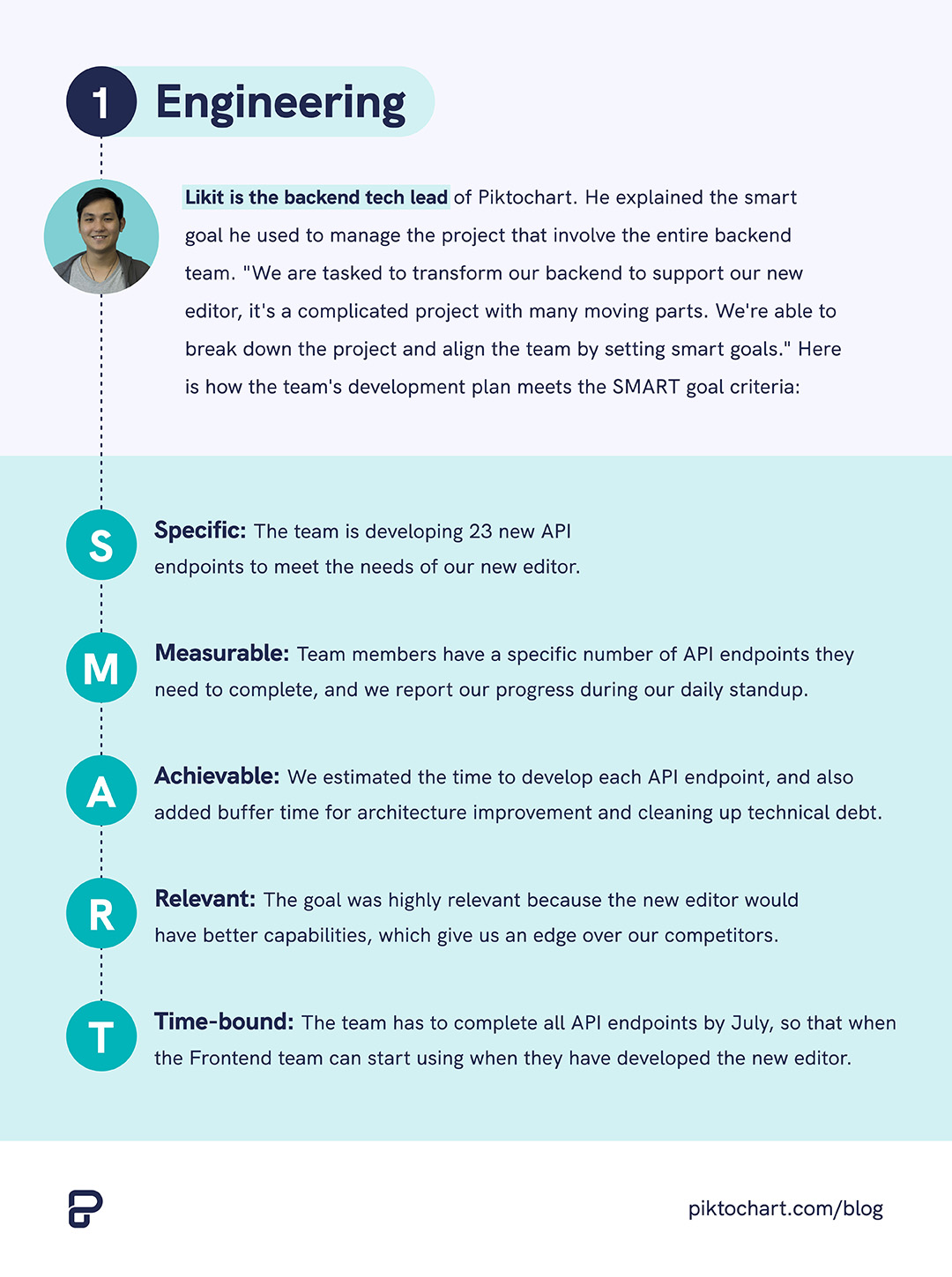
Finance
Maysyn is the Head of Finance at Piktochart. “We have been looking at profitability as part of our new year’s resolutions to ensure that the company always has enough money to keep running. As such, our SMART goals reflect this reality accordingly,” she adds.
Specific: Ensure company profitability in 11 out of 12 months
Measurable: The expenses must not over the sales in each month.
Achievable: Ensure spending within budget in each month for each team. Monitor sales projection closely to ensure company revenue is on track.
Relevant: Align with company goal on achieving X revenue and Y% profit
Time-Bound: Track the results end of each month
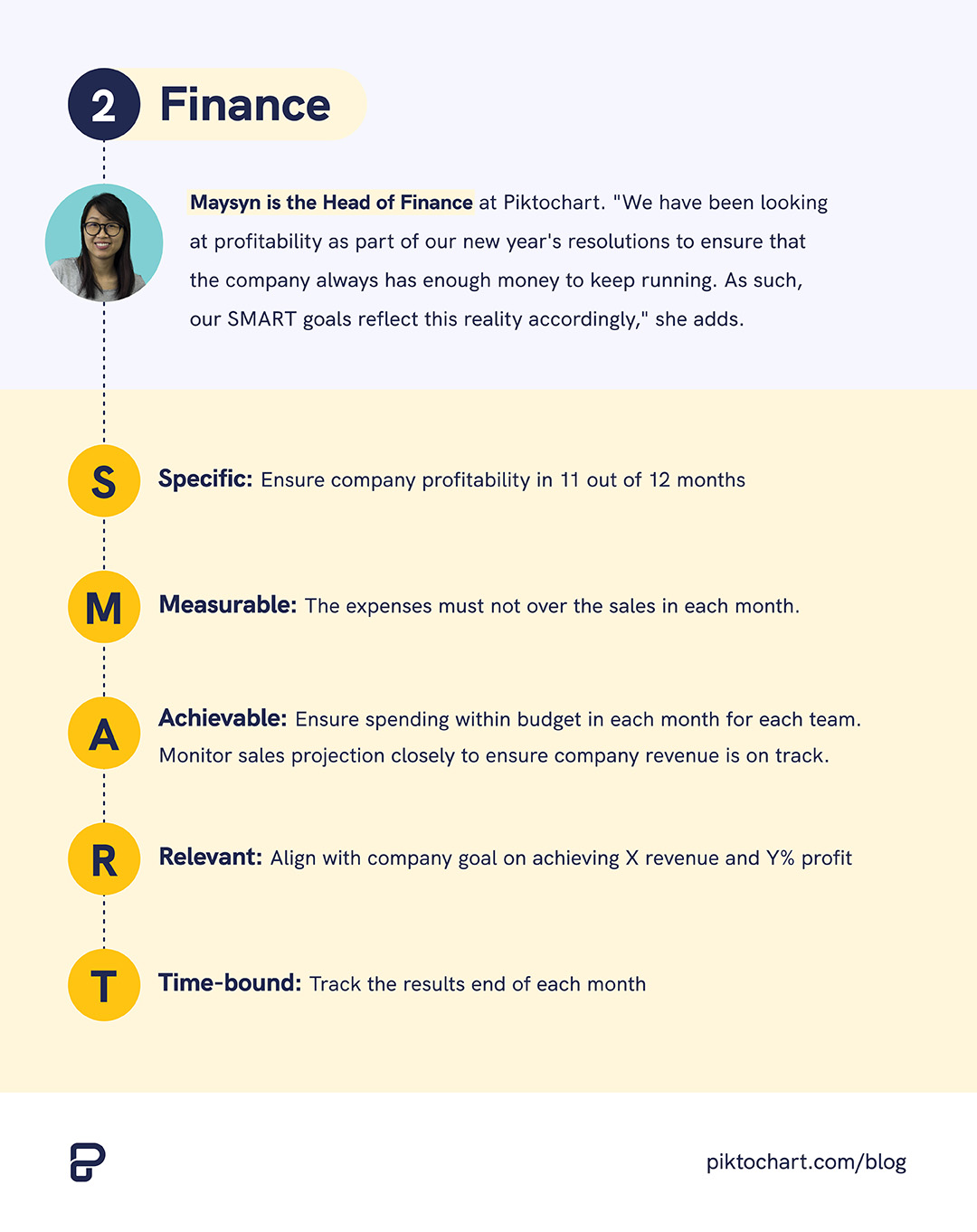
Communications Design
Natasya, our Head of Communications Design says this, “Producing quality templates at a good cadence is what my team tries to do with our available resources. We use the SMART goal in the form of OKRs for the team’s goal attainment:”
Specific: The team needs to generate X templates each week.
Measurable: The team needs to generate X templates per week (26% increase). 40% long templates and 60% short and medium templates.
Achievable: We believe that this is achievable based on our average templates created X templates per week.
Relevant: This goal is essential to provide highly relevant templates to keep our user creating consistently, discovering new use cases and to keep us competitive with our competitors.
Time-bound: Our goal is to generate X templates per designer, per week in Q3 2023.
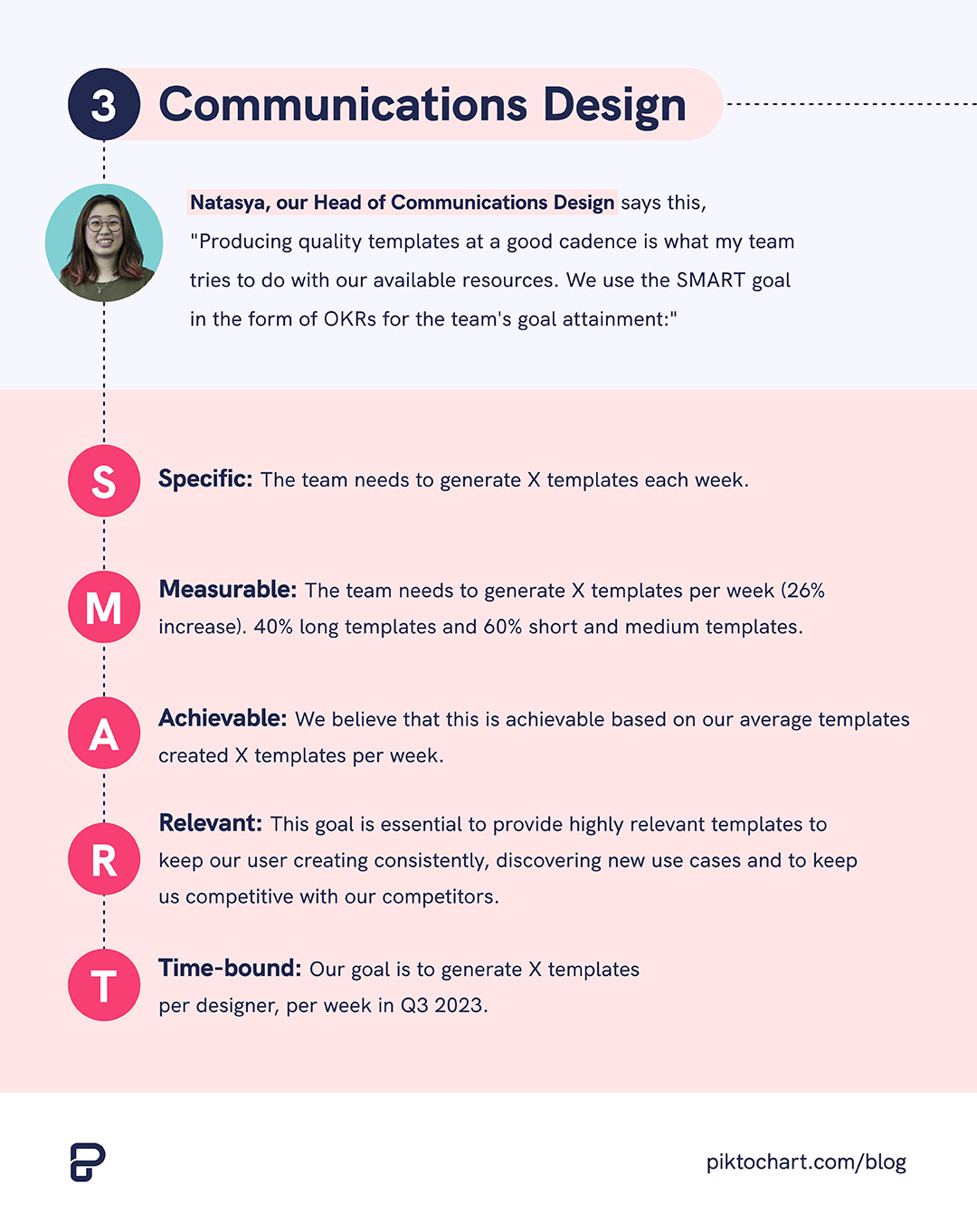
HR
Piktochart doesn’t have a dedicated HR resource at the moment, after we moved to the manager of one concept. We however work with freelance recruiters to acquire talent for the company. Here’s the SMART goal setting process for recruitment:
Specific: Close our 4 vacancies within 90 days.
Measurable: We want quality applicants (employees who end up getting retained in the company in their first year and have good performance reviews) and to close these vacancies within 90 days.
Achievable: It is not actually achievable to close all 4 within 90 days. However, 2 out of 4 vacancies are possible.
Relevant: We would like to hire star players and move quickly to remove bottleneck.
Time-bound: 90 days
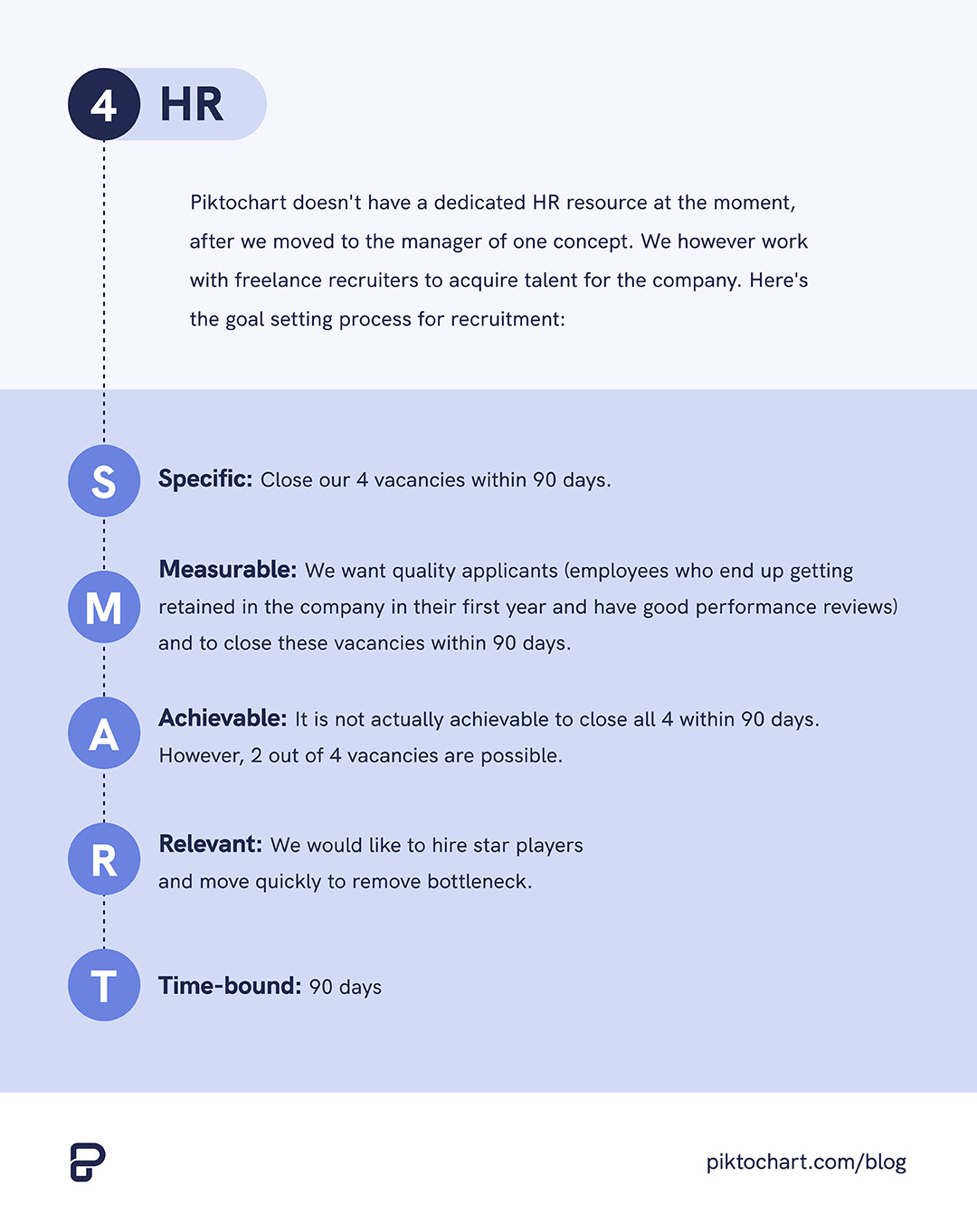
Customer support
Carmen, our Customer Support team lead quips, “We are in a competitive market, and because of that, top-notch customer support matters. SMART goal setting really helps us to translate this into action and not stay in our comfort zone.”
Specific: The goal is to lower our first response time from 1 hour to 45 minutes.
Measurable: To measure this, we will compile a weekly report of our average response time.
Achievable: This is achievable based on our average response time of 1 hour. We will increase shift coverage to help close the gaps between shifts.
Relevant: In the SAAS industry, customers expect a quick reply. In this research done by Sitebuilder, 21% of the companies reply in less than 1 hour. To remain competitive in our industry and provide outstanding customer experience, a quick response time is very important.
Time-bound: Our goal is to hit this in Q3 along with the extra shift coverage.
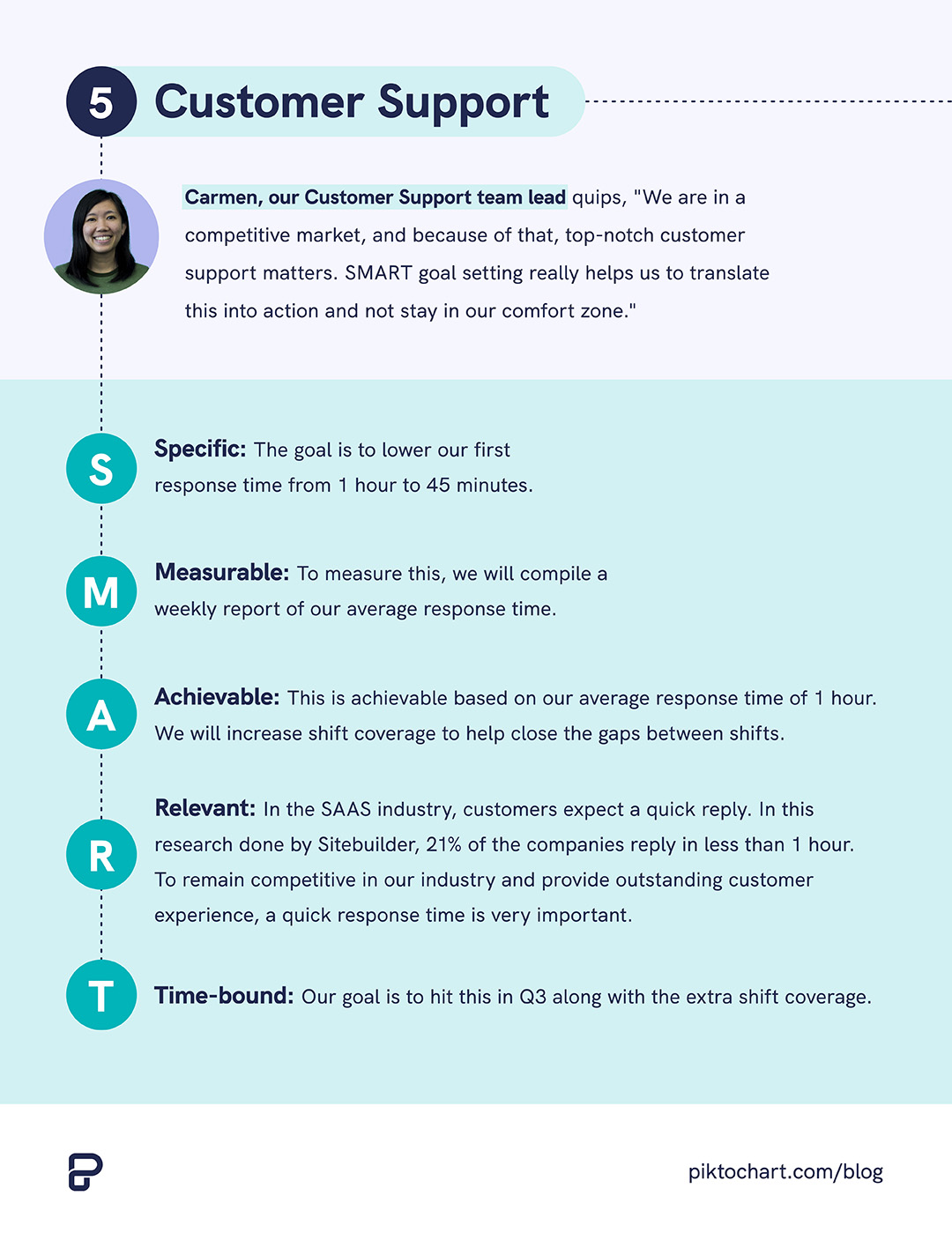
Marketing
Netty, our Head of Marketing specifically adds, “We have been refocusing our efforts on search engine optimization (SEO) efforts in 2023. The new SMART goals reflect that.”
Specific: We want to increase our search traffic by 20% year on year by end of Q4 2023.
Measurable: Easily measurable through rankings, organic traffic and results.
Achievable: Rankings can always be improved through experimentation, so this is achievable.
Relevant: We have historically been able to increase search traffic by 20% yoy.
Time-bound: This is a 12 months project beginning Jan 2023.
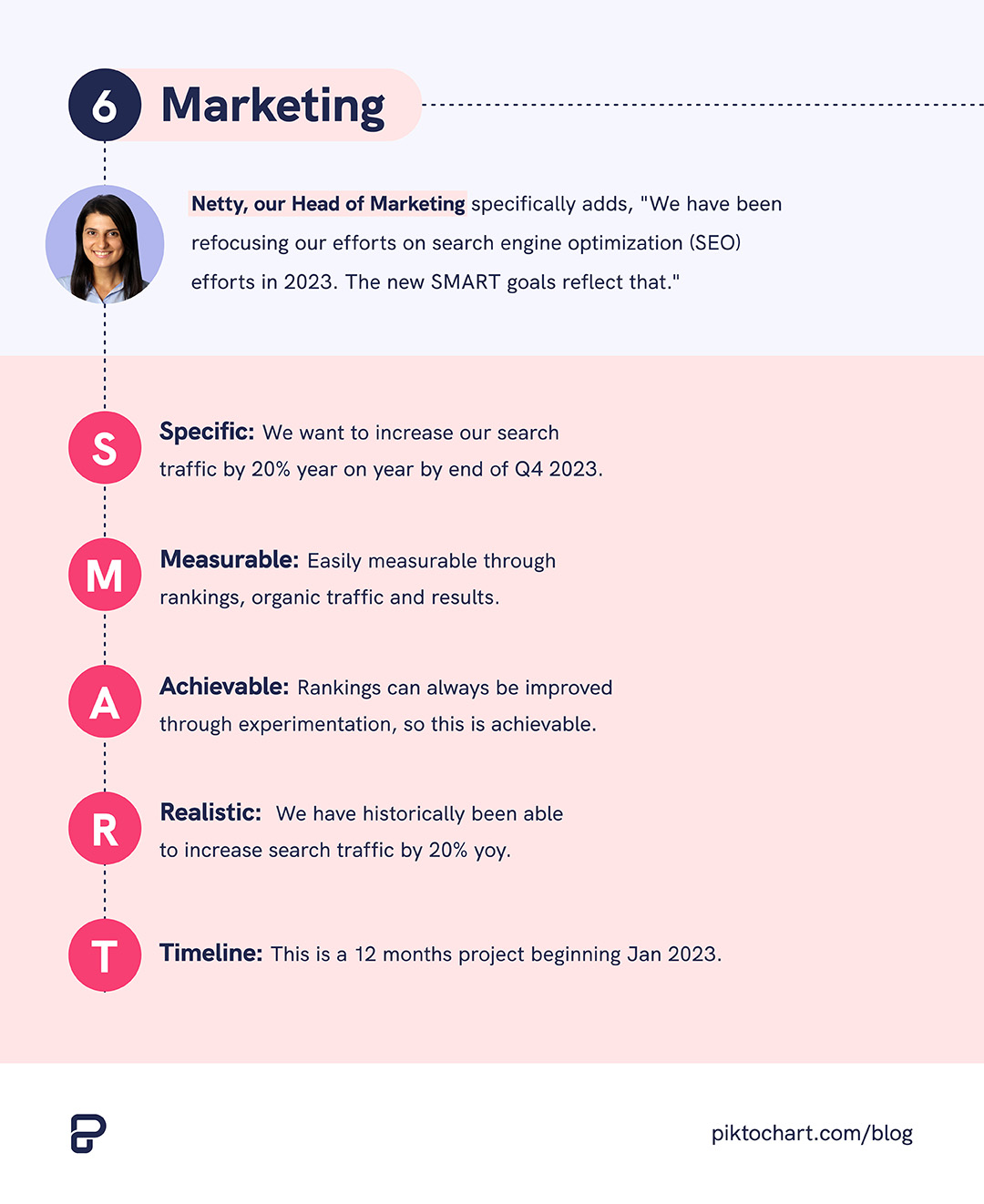
Try one of Piktochart’s Free SMART Goal templates
Use Piktochart for free to write a SMART goal with one of these SMART goals template! Each of the templates has SMART Goals acronym and is easy to customize and fill in. Sign up for free to access more templates.
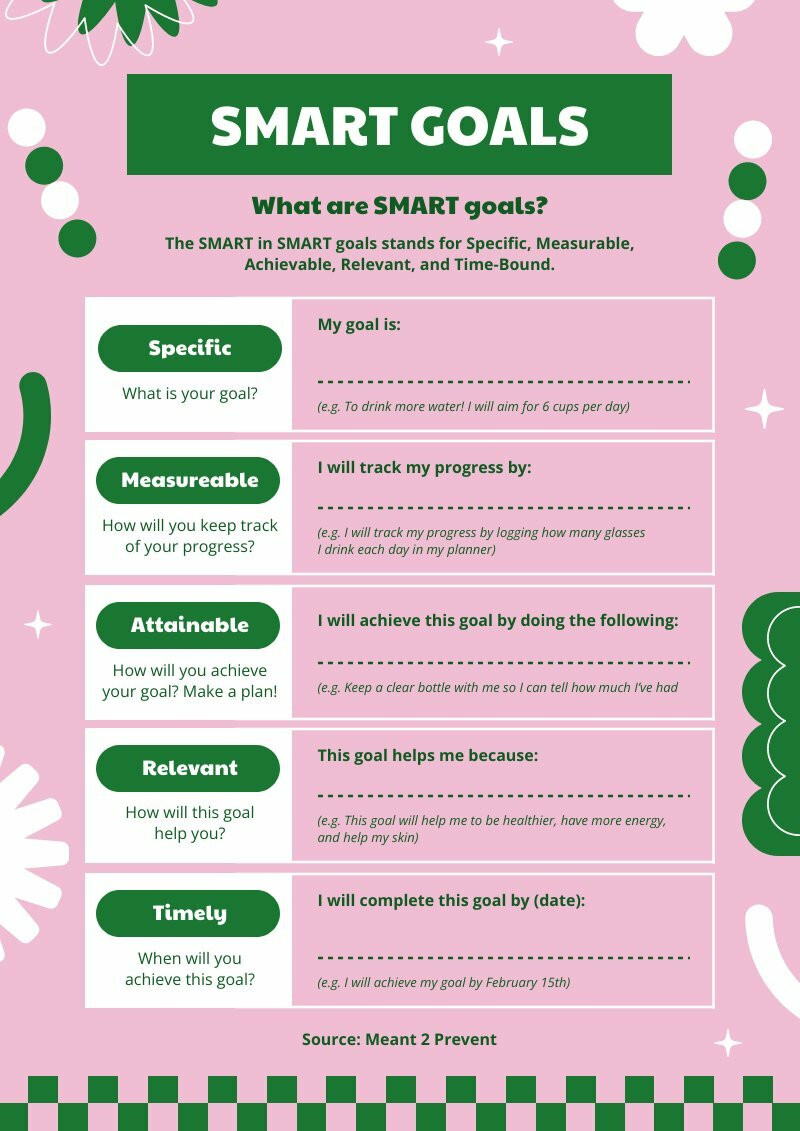
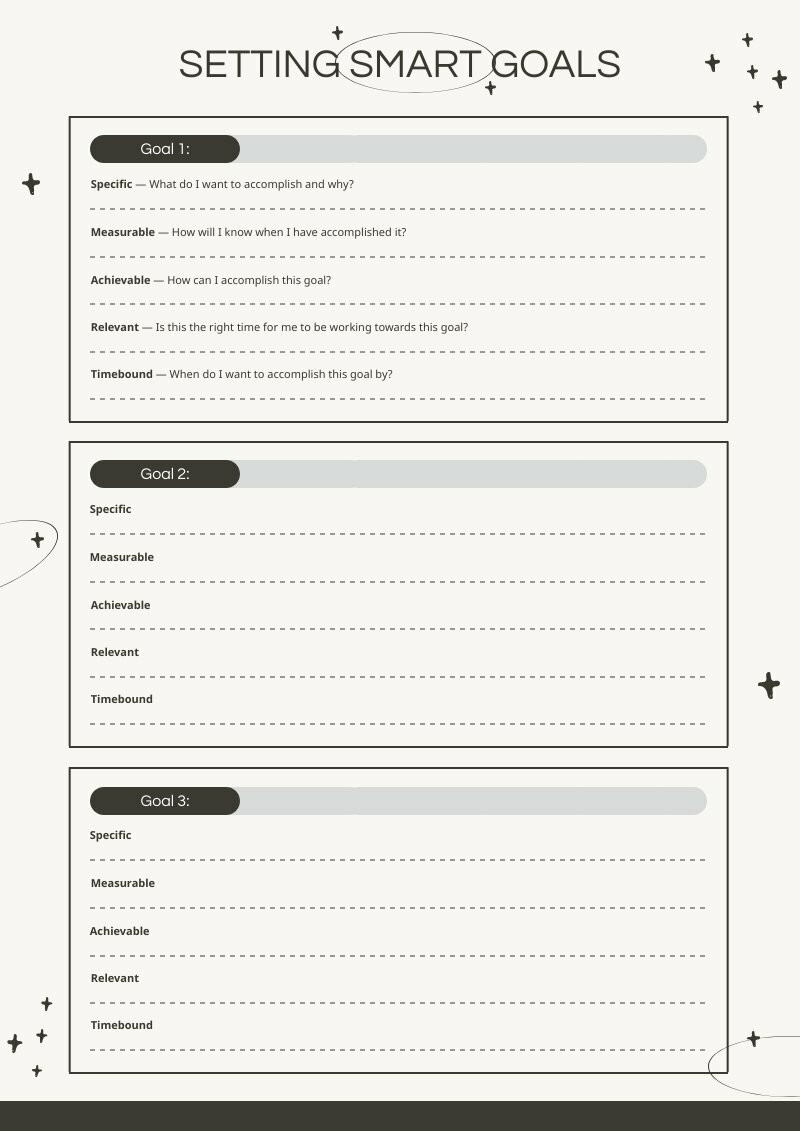
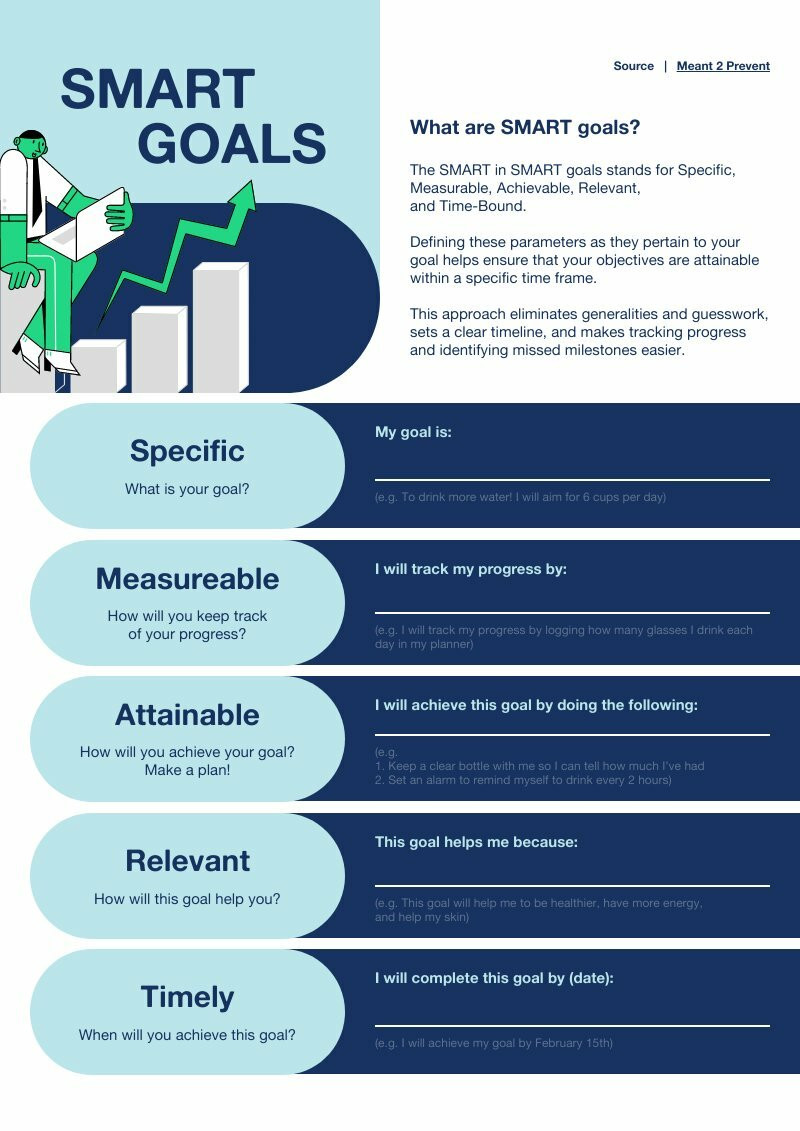
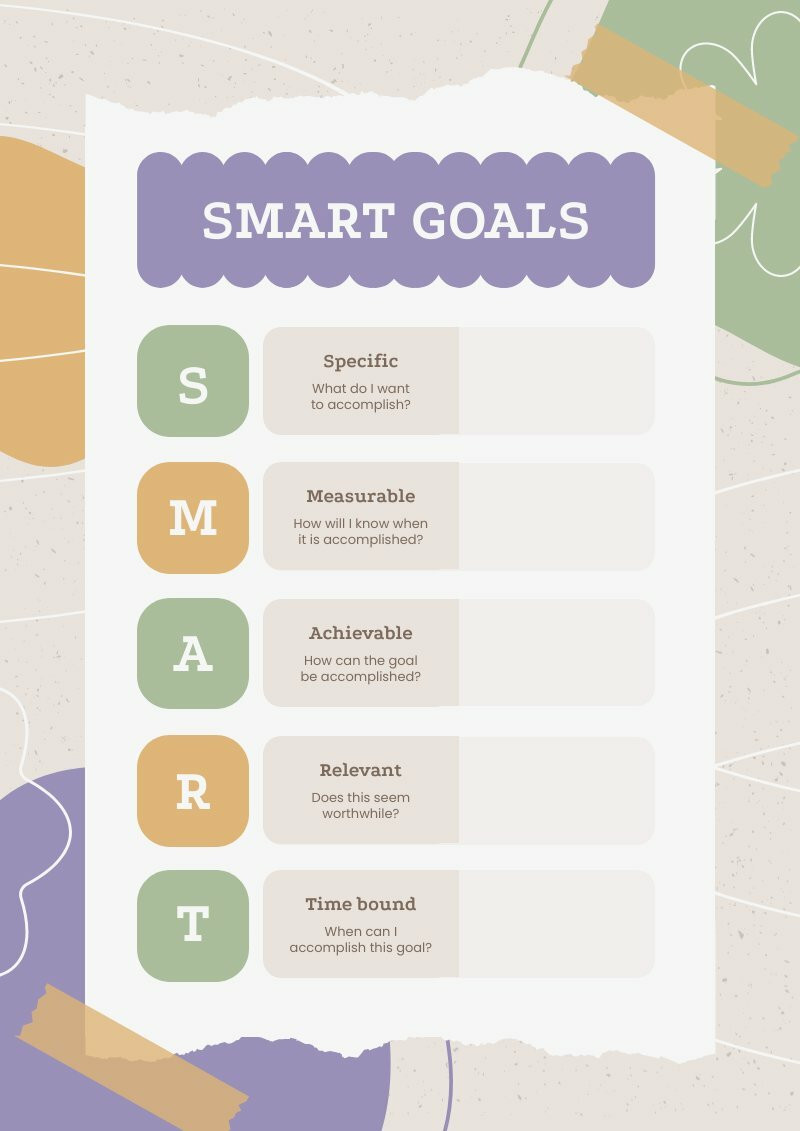
How are SMART goals different than OKRs?
Both SMART Goals and OKRs (Objectives and Key Results) are management methodologies designed to help set, track, and achieve goals. They share similarities in aiming for clarity, measurability, and alignment with broader objectives. However, there are also some key differences:
1. Focus and Scope
SMART Goals are often more detailed and task-oriented. They’re great for individual or small team goals that are relatively short-term and more narrowly focused.
OKRs, on the other hand, tend to be higher-level and more strategic. They’re often used for company-wide goal setting and aligning different departments towards a common objective.
2. Structure
A SMART Goal or SMART criteria is a single statement that includes all elements of Specific, Measurable, Achievable, Relevant, and Time-bound in one, SMART goal template.
An OKR consists of two goals template an Objective, which defines a clear direction, and 2-5 Key Results, which are specific measures used to track the achievement of that objective. OKRs often encourage ambitious goals with the understanding that full achievement is a stretch and that reaching a large percentage of the goal still represents significant progress.
3. Measurability
With SMART Goals, the ultimate goal and expectation is usually to fully achieve the goal as measurable goals is the “A” acronym of SMART. This makes them great for clear, definable targets that need to be met.
While both systems emphasize measurability, OKRs often encourage more aggressive, aspirational goals where achieving 70-80% is considered success. This is based on the premise that setting and striving for “moonshot” goals can drive more innovation and progress. “Write meaningful objectives” is often the motto.
4. Alignment and Transparency
SMART Goals can also be shared and aligned, but there isn’t as strong an emphasis on this aspect, and it largely depends on how the organization chooses to implement them.
OKRs place a strong emphasis on alignment and transparency. The idea is that everyone in the organization, from the CEO to the intern, should have OKRs, and they should all be able to see each other’s OKRs to see how their efforts are contributing to the overall objectives of the company.
Both systems can be highly effective when used correctly, and many organizations use a mix of both. The choice between the two often depends on the specific needs and structure of the organization, the nature of the business goals, and personal or team preferences.
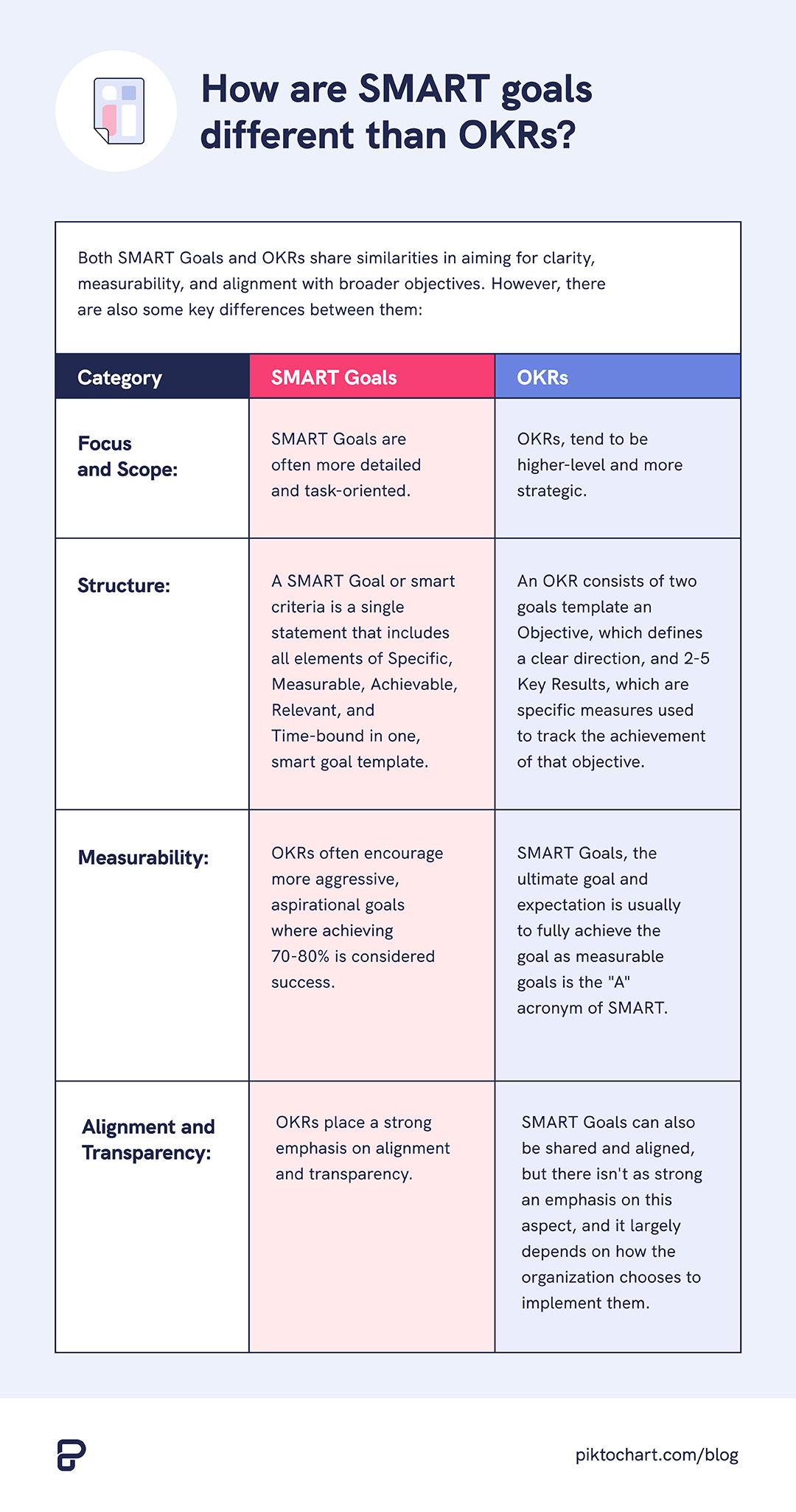
In conclusion
To sum it up, companies aiming for success in today’s complex business environment should wholeheartedly embrace SMART goals. As the great management guru Peter Drucker once wisely said, “What gets measured, gets managed.”
By implementing SMART goals, companies create a culture of clarity, accountability, and achievement, paving their way to success with efficiency and effectiveness.
Piktochart is an intuitive, collaborative tool with an objective of making communication easier and more effective at your workplace. Give it a try for free.
